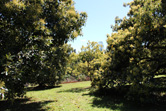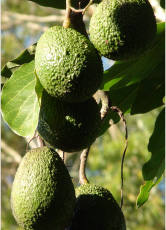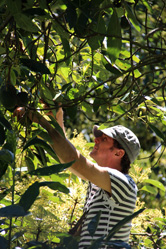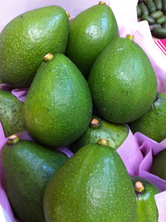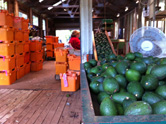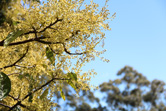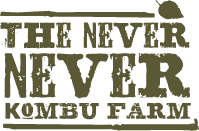AVOCADOS
The Never Never Kombu Farm currently grows 12 different varieties of avocado. These include Fuerte, Hass, Reed, Shepard, Sharwil, and the West Indian.Avocados actually have over 1,000 different named varieties because each seed planted from a parent tree is different from its predecessor. Only a small number of avocados are actually grown and sold commercially. These varieties are put into three main groups: Guatemalan, Mexican and West Indian.
Guatemalan
The Hass variety of avocado is a member of the Guatemalan group, which accounts for about 75 percent of the total crop produced in Australia. This group is native to the highlands of Central America, Ecuador and Mexico. They are a winter cultivar and mature within nine to 14 months. A large fruit with a rough skin, Guatemalan avocados have the most hybrids that are used for commercial selling. They grow to roughly 2.5 kgs and have small seeds that are tightly placed within the avocado.
Mexican
Mexican avocados are native to the highlands of Mexico, the Andes Mountains and Chile. They develop quickly and ripen within six to eight months. These are a small fruits, weighing in at only 500 gms or less. Fuerte is an example of this variety of avocado. Mexican avocados are typically grown in higher altitudes and are able to withstand cold temperatures. The fruit is dark green in color and has a smooth skin. The seeds are large compared to the relative size of the fruit and has a high fat content compared to the other varieties.
West Indian
West Indian avocados are actually not native to the West Indies, but to the lowlands of Central and South America. They have a light green color and smooth skins. They grow in warm climates and they mature in the summer months after six to nine months. These are one of the larger varieties, reaching up to 2.5 kgs and are the lowest in fat content. Because of their thin skin they are susceptible to insect damage but this does not detract from their creamy texture and sweet taste.
back to top
Following are descriptions of some of the most popular varieties, grown on The Never Never Kombu Farm:
Fuerte
A Mexican/Guatemalan cross originating in Puebla, the Fuerte earned its name, which means strong in Spanish, after it withstood a severe frost in California in 1913. It has medium-sized, pear-shaped fruit with a green, leathery, easy to peel skin. The creamy flesh of mild and rich flavour has at least 18% oil when ripe. The skin ripens green. Tree size is 6 by 4 meters.
Hass
While dozens of cultivars are grown, the Hass avocado is today the most common. It produces fruit year-round and accounts for 80% of cultivated avocados in the world. All Hass avocado trees are descended from a single "mother tree" raised by a mail carrier named Rudolph Hass, of California . Hass patented the productive tree in 1935. The "mother tree", of uncertain subspecies, died of root rot and was cut down in September, 2002. Hass trees have medium-sized (150–250 g), ovate fruit with a black, pebbled skin. The flesh has a nutty, rich flavour with 23% oil being desirable. A hybrid Guatemalan type, it can withstand temperatures to −3°C . Its tree size is 6 by 4 meters. Hass are available from May to December in this area depending on oil content and weather.
Reed
Developed from a chance seedling found in 1948 by James S. Reed in California, Reed has large, round, green fruit with a smooth texture and dark, thick, glossy skin. Smooth and delicate, the flesh has a slightly nutty flavour. The skin ripens green. A Guatemalan type, it is frost hardy. Tree size is about 5 by 4 meters. In this area available September to November depending on weather and oil content.
back to top
Sharwil
Predominantly Guatemalan, with some Mexican race genes, Sharwil was selected in 1951 by Sir Frank Sharpe at Redland Bay, southern Queensland. The name "Sharwil" is an amalgamation of Sharp and Wilson (J.C. Wilson being the first propagator). Scions were sent from Australia to Hawaii in 1966. A medium-sized fruit with rough green skin, it closely resembles the Fuerte, but is slightly more oval in shape. The fruit has greenish-yellow flesh with a rich, nutty flavor and high oil content (20–24%), and a small seed. The skin is green when ripe. It represents more than 57% of the commercial acreage in Hawaii, and represents up to 20% of all avocados grown in New South Wales. It is a regular and moderate bearer with excellent quality fruit, but is sensitive to frost. Disease and pest resistance are superior to Fuerte.
West Indian
This particular fruit is of unknown variety at this stage. It has particularly creamy, rich flesh which sweetens as it ripens. It is not widely available. Mature fruit are susceptible to the fruit spotter but this does not detract from their delicious flavour. Usually available from April to July.
back to top of page
